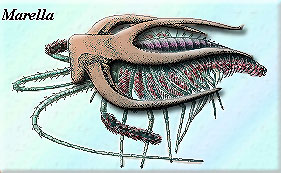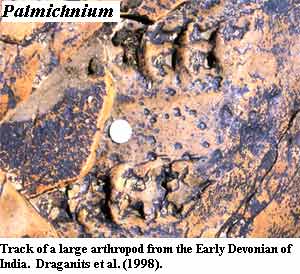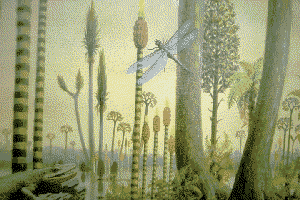| Palaeos: |  |
Paleozoic |
| Paleozoic Era | Paleozoic Era - 4 |
| Page Back | Back: Neoproterozoic | Back: Proterozoic | Up: Phanerozoic | Unit Home |
| Page Next | Next: Mesozoic | Down: Cambrian | Timescale |
| Palaeos: |  |
Paleozoic |
| Paleozoic Era | Paleozoic Era - 4 |
| Page Back | Back: Neoproterozoic | Back: Proterozoic | Up: Phanerozoic | Unit Home |
| Page Next | Next: Mesozoic | Down: Cambrian | Timescale |
Plant life on land follows a very different evolutionary pattern - in terms of primary ecosystems - to both land animals and marine life. Whilst the division of the main evolutionary stages of multicellular life into Palaeozoic, Mesozoic, and Cenozoic is described in many popular science books and educational websites, few people are aware that these terms apply to animal life only. Plant life followed a different route, and the paleobotanical time-eras of Palaeophytic, Mesophytic, and Cenophytic are only approximately equivalent. Palaeophytic refers to the primarily spore-bearing (and a few primitive seed-bearing) Paleozoic vascular flora, which appeared in the Middle Ordovician period and die out quite a few millions of years before the end of the Paleozoic (latest early Permian and earlier). In the middle Permian the gymnosperm-dominated Mesophytic flora emerges (although Mesophytic type plants go back to the Carboniferous, just as some Paleophytic plants survive even to this day), and this flourishes right up until the middle and later Cretaceous. MAK010115
 Arthropods
apparently got off to an early start. By the time of the Burgess
Shale in the Middle Cambrian arthropods
and their immediate relations were already the most diverse and successful group of animals. The
anomalocarids
(which were either arthropods or their immediate sister group) were the world's
earliest known large predator, with lengths approaching 2 meters. Trilobites
are well known from Cambrian Epoch 2 onwards,
since their hard carapace fossilizes easily. In addition to trilobites and
several other high-level taxa of extinct arthropods, it is almost certain that
many of the important arthropod groups of today had already diverged by this
time, including the chelicerates,
crustaceans, and
arachnids. Xiphosurans
and some derived crustacean groups are known by the end
of the Cambrian. At that time the trilobites experienced several
rounds of turnover as the nature of the sea floor environment began to
change. Of the miraculous variety of arthropod in the Burgess Shale, only
4 basic designs survived the end of the Cambrian. Of the four, the trilobites
were extinguished at the end of the Permian. The remaining three are the insects
(Hexapoda), the crustaceans, and the chelicerates.
Arthropods
apparently got off to an early start. By the time of the Burgess
Shale in the Middle Cambrian arthropods
and their immediate relations were already the most diverse and successful group of animals. The
anomalocarids
(which were either arthropods or their immediate sister group) were the world's
earliest known large predator, with lengths approaching 2 meters. Trilobites
are well known from Cambrian Epoch 2 onwards,
since their hard carapace fossilizes easily. In addition to trilobites and
several other high-level taxa of extinct arthropods, it is almost certain that
many of the important arthropod groups of today had already diverged by this
time, including the chelicerates,
crustaceans, and
arachnids. Xiphosurans
and some derived crustacean groups are known by the end
of the Cambrian. At that time the trilobites experienced several
rounds of turnover as the nature of the sea floor environment began to
change. Of the miraculous variety of arthropod in the Burgess Shale, only
4 basic designs survived the end of the Cambrian. Of the four, the trilobites
were extinguished at the end of the Permian. The remaining three are the insects
(Hexapoda), the crustaceans, and the chelicerates.
 By the Ordovician, some arthropods
were at least partially terrestrial. Several different types of arthropod
land trackways of this age are now known. Identifiable millipede
and arachnids, including scorpion,
parts are known from the Silurian. In the seas, eurypterids
also got their start during the Ordovician, but only became dominant predators
in the Silurian. Xiphosurans
(hoseshoe crabs) also flourished in the Silurian. Trilobites were
somewhat less common than in the Cambrian, but continued as an important part of
the sea bottom fauna.
By the Ordovician, some arthropods
were at least partially terrestrial. Several different types of arthropod
land trackways of this age are now known. Identifiable millipede
and arachnids, including scorpion,
parts are known from the Silurian. In the seas, eurypterids
also got their start during the Ordovician, but only became dominant predators
in the Silurian. Xiphosurans
(hoseshoe crabs) also flourished in the Silurian. Trilobites were
somewhat less common than in the Cambrian, but continued as an important part of
the sea bottom fauna.
Terrestrial trace fossils of apparent arthropods are known from the Wenlock (Middle Silurian). Orr et al. (2000). Body fossils of identifiable members of the extinct arachnid group Trigonotarbida have been found as early as the Pridoli (latest Silurian). The manner in which arthropods came to land raises some rather deep evolutionary questions. Terrestrial life is so different from life in in water that the barrier to evolution is high. One might reasonably expect that that the transition would occur only rarely and that the first of any large group to accomplish the feat would radiate explosively, preventing any later group which was even remotely similar from getting a foothold on land. So, for example, all land vertebrates descend from a single common ancestor who established itself on land in the Late Devonian. The same can probably be said of land plants, as well as terrestrial worms (Annelida) and mollusks. Arthropods, however, seem to have independently evolved terrestrial forms at least half a dozen times over a relatively long period of time (Pridoli to Mississippian). See, e.g., Klok et al. (2002).
Arthropods were well-established on land in the Devonian, and seem to have reached impressive size in some cases. The earliest known Hexapoda -- but not yet insects -- were discovered in Devonian rocks. Terrestrial spiders were present, but trilobites began a serious long-term decline in the seas. The increasing biomass of land plants and higher oxygen levels by the end of the Devonian probably led to the evolution of terrestrial, herbivorous forms by the end of that period, possibly including the first insects.
Insects were certainly present during the Carboniferous, and all of the major groups had diverged by the end of Paleozoic time. Insects with folding wings had evolved by the Pennsylvanian (Late Carboniferous). A few of these, particularly some dragonflies and spiders, reached very large sizes. This may have been due to abnormally high oxygen levels during the Carboniferous. Dudley (1998). However, most Paleozoic insects were as small as insects today. In the seas, the trilobites and eurypterids declined and became extinct at the end of the Permian. Crustaceans became increasingly diverse and successful.
Image: Palmichnium image from Draganits et al. (1998)
ATW040710. Revised ATW050914. Text and Marella image public domain. No rights reserved.
Links: The SUNY Cortland Geology Department has a good introduction to the Paleozoic evolution of arthropods. Trilobites were the most succesful group of arthropods for most of the early Paleozoic. Sam Gon has the most succesful of trilobite sites -- and with good reason. Trigonotarbids are introduced at the UCMP site.

The following quotation is from Terrestrial Ecosystems Through Time (pp.289-290) and gives an excellent overview of terrestrial Paleozoic biota:
The Paleozoic was the time during which terrestrial ecosystems were organized and assembled. The plants, invertebrates, and tetrapods can be thought of as three separate subsystems of the larger terrestrial ecosystem. Dominance-diversity patterns, structure, and interactions within these subsystems modernized more or less independently and at different rates throughout most of the Paleozoic. Concomitantly, these three separate subsystems became integrated through trophic interactions and the creation or modification of habitat conditions. This partitioning of ecosystems into "phylogenetic" subunits differs radically from the organization of highly integrated modern systems.
The appearance of structurally and ecomorphically modern plant communities in some parts of the landscape primarily during the Late Devonian and Early Carboniferous included the evolution of life histories, particularly seed habit, that permitted the exploitation of a wide variety of terrestrial environments. The independent evolution of arborescence in nearly all major groups of plants was key to the development of multistratal forests in some habitats at this time. By the Late Carboniferous, complex forest structure and a wide variety of forest profiles and dynamics were clearly in existence across all major land masses.
Global provincialization of vegetation began during the Early Carboniferous and increased more or less continuously until the Permian, when it reached its Paleozoic maximum; this was perhaps the greatest provincialization known prior to the later Tertiary. Such provincialism was made possible by several factors. The physical opportunities increased in diversity and abundance during the Paleozoic as environments changed globally. Because the plants were at the base of the major terrestrial radiation, they evolved increasing tolerances to demanding physical conditions and expanded the extent of the vegetated land surface. This expansion into unoccupied parts of the terrestrial environment was accompanied by an increase in local and regional vegetational heterogeneity, a consequence of local variation in both physical conditions and evolutionary dynamics.
The first animal groups to exploit plant productivity were the arthropods, and then primarily as detritivores. Detritivory was the main entry point of plant primary productivity into animal food webs until the end of the Early Permian. Herbivory, largely by insects, is known from the Early Carboniferous and may have existed in the Devonian. Herbivory expanded rapidly during the Late Carboniferous and was an established part of ecosystem dynamics by the Stephanian or possibly late Westphalian and into the Early Permian. As suggested by the large size of medullosan pollen, insect pollination probably had evolved by the Westphalian. The selective effects of arthropods on plants may be seen in the evolution of sclerotic seed coats and other structural features that would have served to deter post- and pre- dispersal predation. Clear evidence of damage to living foliage does not appear until the later Westphalian.
Tetrapods were the final element to enter the web of interactions in terrestrial communities. They began, and continued, as carnivores and insectivores through the Carboniferous and Early Permian, situated at the ends of long food chains that were mediated primarily by arthropod detritivory. Although predation on insect herbivores would have shortened some of these pathways and added trophic links to the system, it was not until the expansion of tetrapod herbivory in the late Early Permian that a full integration of the three subsystems was established. The integration had progressed greatly by the Late Permian. However, even by the end of the Paleozoic, the tetrapod component of ecosystems was distinctly different in the sizes, modes of feeding, and range of resources exploited from Mesozoic and younger ecosystems
The following sequence of terrestrial biotas is suggested. These do not always follow or equate with the Marine succession:
Ordovician-Early Silurian (proto-land plants; simple invertebrates)
Siluro-Devonian (early vascular plants, progressing to small trees, many types of arthropods)
Late Devonian - middle Frasnian to late Famennian (proper trees, 30 meters tall, two successive dynasties of tetrapods)
Early Carboniferous (ice age begins, smaller trees; early tetrapods, rhizodont fish top freshwater predators, giant semi-aquatic eurypterids)
Permo-Carboniferous - late Carboniferous to early Permian (ice age continues, mighty tropical coal swamp forests, many tetrapods and early reptiles, winged insects appear, including many giant forms)
Late Permian - drying of climate, extinction of swamp trees and many amphibians and reptiles; therapsids take over, Mesozoic trees and endopterygous insects appear.
| Page Back | Unit Home | Page Top | Page Next |